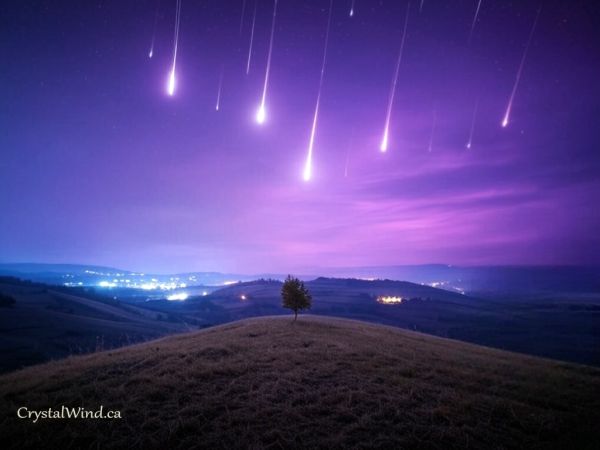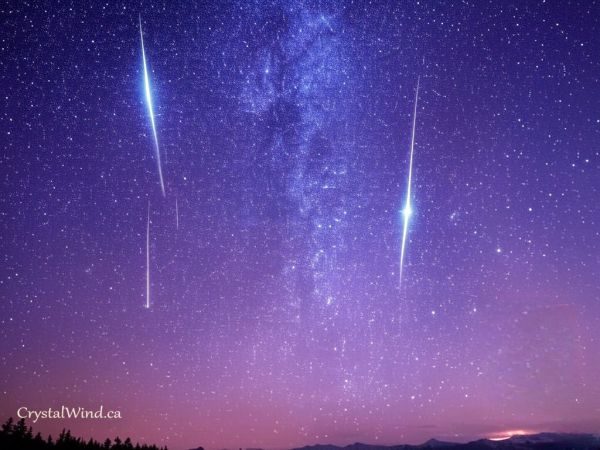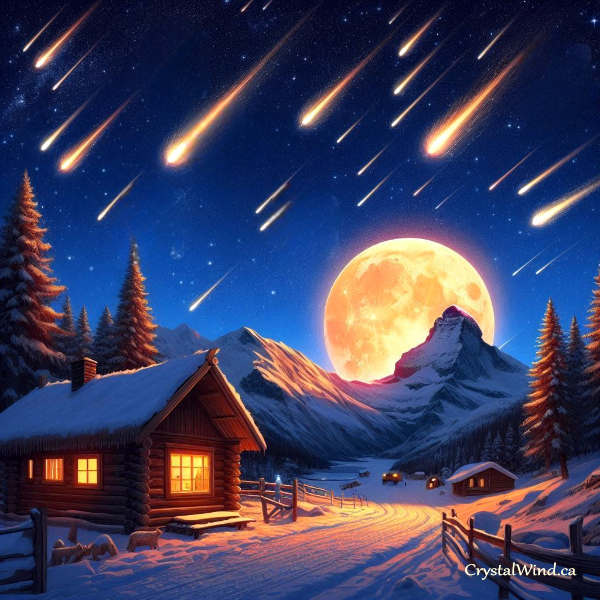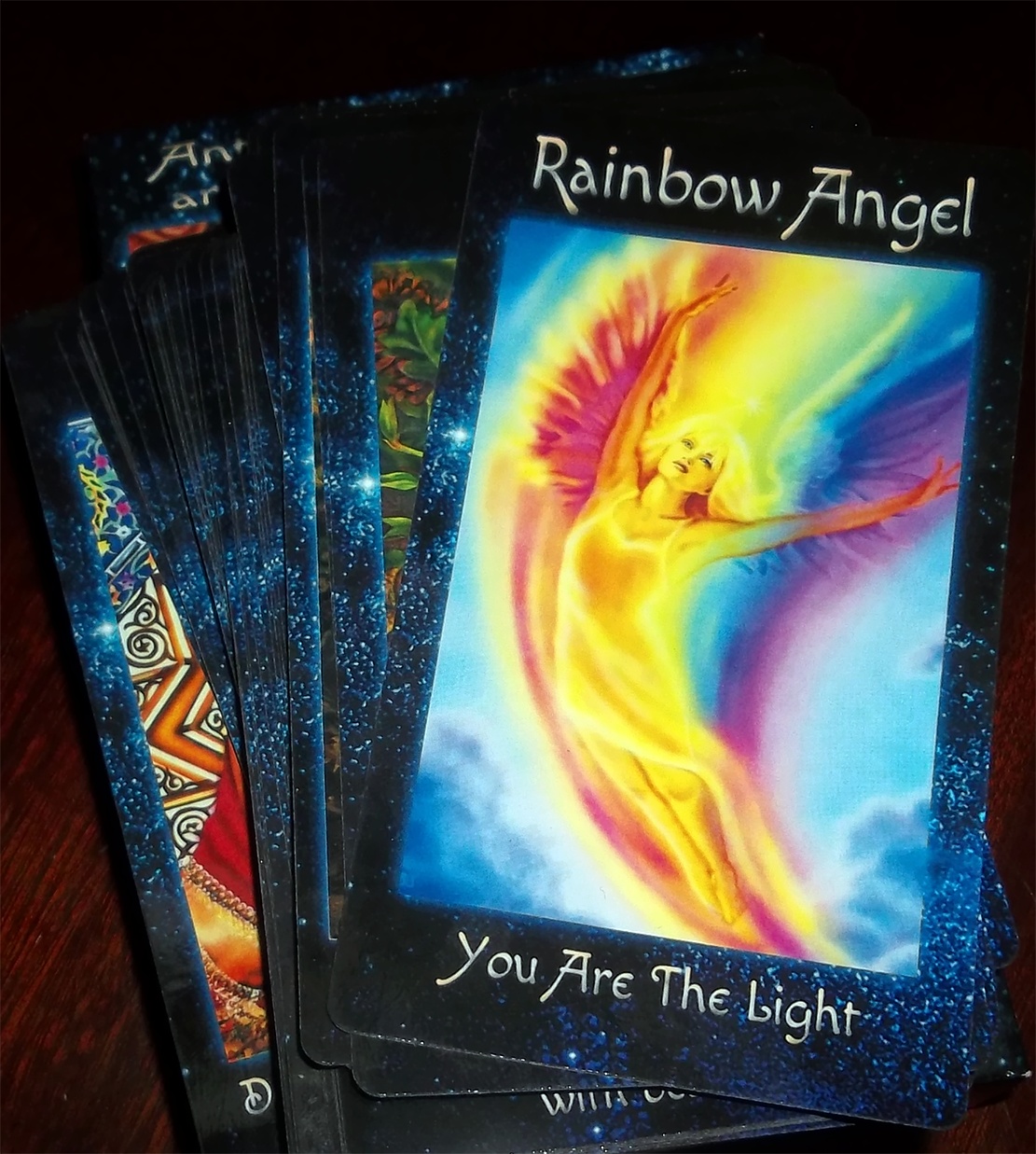Meteor Showers Calendar: Must-See Dates for 2025-2026!
- Details
- Written by And-El
- Views: 2924

A Celestial Spectacle:
Your Detailed Meteor Shower Calendar for 2025-2026.
There’s something magical about gazing up at the night sky and witnessing a meteor shower—a cascade of "shooting stars" streaking across the heavens. Whether you're an avid stargazer or a casual observer, meteor showers offer a breathtaking, accessible way to connect with the cosmos. In 2025 and 2026, the skies will light up with some of the most awe-inspiring meteor showers, each with its own unique characteristics and viewing opportunities. This detailed Meteor Shower Calendar for 2025-2026 will guide you through the best celestial events, providing peak dates, expected rates, moon phases, and tips to maximize your experience. Let’s dive into the cosmic wonders awaiting us!
What Are Meteor Showers?
Before we explore the calendar, let’s briefly unpack what meteor showers are. These celestial events occur when Earth passes through streams of debris—tiny particles of dust and rock—left behind by comets or asteroids. As these meteoroids enter our atmosphere at high speeds, they burn up, creating brilliant streaks of light. Each shower is named after the constellation from which the meteors appear to radiate, known as the "radiant." The frequency of meteors per hour under ideal conditions is called the Zenithal Hourly Rate (ZHR), though actual visibility depends on factors like light pollution, weather, and the moon’s phase.
Now, let’s embark on a two-year journey through the skies!
Meteor Shower Calendar 2025
-
Quadrantids
- Active Period: December 26, 2024 – January 16, 2025
- Peak Date: January 2-3, 2025
- ZHR: Up to 120 meteors per hour
- Moon Phase: 11% waxing crescent
- Best Viewing Time: After midnight until dawn
- Radiant: Near the constellation Boötes
The Quadrantids launch 2025 with a spectacular, short-lived peak of up to 120 meteors per hour. Originating from asteroid 2003 EH1, this shower often dazzles with fireballs—bright, colorful bursts. A slim crescent moon sets early, leaving dark skies for Northern Hemisphere viewers, where the radiant rises high. Southern observers see fewer meteors due to the radiant’s position. Find a dark, rural spot, face north, and enjoy this winter treat.
-
Lyrids
- Active Period: April 15 – April 29, 2025
- Peak Date: April 21-22, 2025
- ZHR: 18 meteors per hour (surges to 100 possible)
- Moon Phase: 40% waning crescent
- Best Viewing Time: Late evening to dawn
- Radiant: Near the constellation Lyra
From Comet C/1861 G1 Thatcher, the Lyrids bring a modest but reliable display, with occasional outbursts. In 2025, a waning crescent moon slightly brightens the sky—block it with a tree or building for clearer views. The radiant peaks at dawn, favoring Northern Hemisphere watchers, though fireballs can delight all.
-
Eta Aquariids
- Active Period: April 15 – May 27, 2025
- Peak Date: May 3-4, 2025
- ZHR: 50 meteors per hour
- Moon Phase: 44% waxing gibbous
- Best Viewing Time: Pre-dawn hours
- Radiant: Near the constellation Aquarius
Halley’s Comet gifts us the Eta Aquariids, a Southern Hemisphere favorite with swift, trailing meteors. Northern viewers catch fewer (10-30 per hour). In 2025, a waxing gibbous moon sets before dawn, offering dark skies during peak hours. Lie flat, face east, and savor this pre-dawn show.
-
Delta Aquariids
- Active Period: July 18 – August 21, 2025
- Peak Date: July 29-30, 2025
- ZHR: 25 meteors per hour
- Moon Phase: 27% waxing crescent
- Best Viewing Time: After midnight
- Radiant: Near the constellation Aquarius
Likely from Comet 96P/Machholz, the Delta Aquariids favor southern skies with faint, steady meteors. A slim crescent moon sets early in 2025, ensuring dark conditions. Look south after midnight for this warm-weather display.
-
Perseids
- Active Period: July 14 – September 1, 2025
- Peak Date: August 12-13, 2025
- ZHR: 50-75 meteors per hour
- Moon Phase: 84% waning gibbous
- Best Viewing Time: Pre-dawn hours
- Radiant: Near the constellation Perseus
- Two Best Viewing Dates and Times:
- August 12, 2025, 2:00 AM – 4:00 AM local time: The radiant is high, and though the bright moon interferes, brighter meteors remain visible—block moonlight with a barrier.
- August 13, 2025, 3:00 AM – 5:00 AM local time: Post-peak, the shower weakens, but pre-dawn darkness still offers a good chance for vivid streaks.
The Perseids, from Comet 109P/Swift-Tuttle, are a summer classic. Bright and swift, they’re a Northern Hemisphere highlight, though a bright moon in 2025 will obscure fainter meteors. Watch pre-dawn, shielding moonlight, for the best chance at brilliance.
-
Orionids
- Active Period: October 2 – November 7, 2025
- Peak Date: October 22-23, 2025
- ZHR: 20 meteors per hour
- Moon Phase: 2% waxing crescent
- Best Viewing Time: After midnight
- Radiant: Near the constellation Orion
Another Halley’s Comet offspring, the Orionids shine under a nearly new moon in 2025. Swift meteors with glowing trains make this a treat for both hemispheres. Look toward Orion after midnight.
-
Leonids
- Active Period: November 3 – December 2, 2025
- Peak Date: November 16-17, 2025
- ZHR: 10-15 meteors per hour
- Moon Phase: 9% waning crescent
- Best Viewing Time: After midnight
- Radiant: Near the constellation Leo
The Leonids (Comet 55P/Tempel-Tuttle) offer a quiet show in 2025, with dark skies thanks to a slim crescent moon. Fast, bright meteors reward patient viewers in both hemispheres—look east after midnight.
-
Geminids
- Active Period: November 19 – December 24, 2025
- Peak Date: December 13-14, 2025
- ZHR: Up to 120 meteors per hour
- Moon Phase: Waning crescent (rises late)
- Best Viewing Time: 10 PM to dawn
- Radiant: Near the constellation Gemini
- Two Best Viewing Dates and Times:
- December 13, 2025, 10:00 PM – 1:00 AM local time: Pre-peak, the moon hasn’t risen yet, offering dark skies and high meteor rates as Gemini climbs.
- December 14, 2025, 1:00 AM – 3:00 AM local time: Peak night, with the radiant near its highest point; face west after moonrise to minimize interference.
The Geminids, from asteroid 3200 Phaethon, often steal the year’s spotlight with bright, slow meteors. A late-rising crescent moon in 2025 ensures dark early hours—perfect for all viewers. Face east and enjoy!
-
Ursids
- Active Period: December 13 – December 24, 2025
- Peak Date: December 21-22, 2025
- ZHR: 5-10 meteors per hour
- Moon Phase: 3% waning crescent
- Best Viewing Time: After midnight
- Radiant: Near the constellation Ursa Minor
The Ursids (Comet 8P/Tuttle) close 2025 modestly, favoring the Northern Hemisphere. A nearly new moon offers dark skies—look north for a subtle, festive finale.

Meteor Shower Calendar 2026
-
Quadrantids
- Active Period: December 26, 2025 – January 16, 2026
- Peak Date: January 3-4, 2026
- ZHR: Up to 120 meteors per hour
- Moon Phase: 100% full
- Best Viewing Time: After midnight (moonlight challenge)
- Radiant: Near the constellation Boötes
The Quadrantids return in 2026 with a brilliant peak, but a full moon will drown out fainter meteors. Block the light and focus north after midnight for fireballs—Northern Hemisphere viewers have the edge.
-
Lyrids
- Active Period: April 15 – April 29, 2026
- Peak Date: April 21-22, 2026
- ZHR: 18 meteors per hour (surges possible)
- Moon Phase: 92% waning gibbous
- Best Viewing Time: Late evening to dawn
- Radiant: Near the constellation Lyra
In 2026, the Lyrids face a bright waning gibbous moon. Watch before moonrise or shield the light for a chance at fireballs. The radiant peaks at dawn, best in the Northern Hemisphere.
-
Eta Aquariids
- Active Period: April 15 – May 27, 2026
- Peak Date: May 4-5, 2026
- ZHR: 50 meteors per hour
- Moon Phase: 13% waning crescent
- Best Viewing Time: Pre-dawn hours
- Radiant: Near the constellation Aquarius
The Eta Aquariids dazzle in 2026 with a slim crescent moon setting early. Southern Hemisphere viewers enjoy up to 50 swift meteors per hour—look east before dawn for glowing trains.
-
Delta Aquariids
- Active Period: July 18 – August 21, 2026
- Peak Date: July 29-30, 2026
- ZHR: 25 meteors per hour
- Moon Phase: 100% full
- Best Viewing Time: After midnight (moonlight challenge)
- Radiant: Near the constellation Aquarius
A full moon in 2026 dims the Delta Aquariids’ faint meteors. Southern skies fare better—block moonlight and look south after midnight for a subdued summer show.
-
Perseids
- Active Period: July 14 – September 1, 2026
- Peak Date: August 12-13, 2026
- ZHR: 50-75 meteors per hour
- Moon Phase: 9% waxing crescent
- Best Viewing Time: Pre-dawn hours
- Radiant: Near the constellation Perseus
- Two Best Viewing Dates and Times:
- August 12, 2026, 2:00 AM – 4:00 AM local time: Peak night with the moon set, dark skies enhance visibility as the radiant soars high.
- August 11, 2026, 3:00 AM – 5:00 AM local time: Pre-peak, still strong activity under dark skies before the crescent moon rises.
The Perseids shine brightly in 2026 with a slim crescent moon setting early. Dark skies amplify this Northern Hemisphere favorite—watch pre-dawn for swift, vivid meteors.
-
Orionids
- Active Period: October 2 – November 7, 2026
- Peak Date: October 21-22, 2026
- ZHR: 20 meteors per hour
- Moon Phase: 79% waxing gibbous
- Best Viewing Time: After midnight
- Radiant: Near the constellation Orion
The Orionids in 2026 face a bright gibbous moon. Watch early after midnight before it rises too high—swift meteors with trains remain visible in both hemispheres.
-
Leonids
- Active Period: November 3 – December 2, 2026
- Peak Date: November 16-17, 2026
- ZHR: 10-15 meteors per hour
- Moon Phase: 43% waxing gibbous
- Best Viewing Time: After midnight
- Radiant: Near the constellation Leo
A waxing gibbous moon in 2026 slightly hampers the Leonids. Watch early or block the light—fast, bright meteors reward patience in both hemispheres.
-
Geminids
- Active Period: November 19 – December 24, 2026
- Peak Date: December 13-14, 2026
- ZHR: Up to 120 meteors per hour
- Moon Phase: 10% waxing crescent
- Best Viewing Time: 10 PM to dawn
- Radiant: Near the constellation Gemini
- Two Best Viewing Dates and Times:
- December 13, 2026, 11:00 PM – 2:00 AM local time: Peak night with dark skies before the slim moon rises, radiant high and active.
- December 12, 2026, 10:00 PM – 1:00 AM local time: Pre-peak, strong rates under dark skies as Gemini ascends.
The Geminids reign supreme in 2026 with a slim crescent moon setting early. Dark skies showcase bright, slow meteors—perfect for all viewers. Face east and marvel!
-
Ursids
- Active Period: December 13 – December 24, 2026
- Peak Date: December 21-22, 2026
- ZHR: 5-10 meteors per hour
- Moon Phase: 78% waxing gibbous
- Best Viewing Time: After midnight
- Radiant: Near the constellation Ursa Minor
The Ursids close 2026 modestly, with a bright gibbous moon rising late. Northern Hemisphere viewers get the best shot—watch north early for faint meteors.
Tips for Meteor Shower Viewing
- Find a Dark Spot: Escape city lights for the best visibility.
- Check the Weather: Clear skies are essential—monitor forecasts.
- Timing is Key: Most showers peak after midnight; pre-dawn often yields more meteors.
- Comfort Matters: Bring a blanket, chair, and warm clothes.
- Eyes on the Sky: Let your eyes adjust to the dark for 20-30 minutes—no phones!
- Moon Strategy: If the moon is bright, block it with trees or buildings.
Final Thoughts
The 2025-2026 meteor shower calendar dazzles with events from the vibrant Quadrantids to the stunning Geminids, each offering a special view of Earth traversing cosmic trails. The Perseids and Geminids, highlighted by prime viewing times, are unmissable spectacles. Blending science and splendor, these showers invite you to grab your calendar, gear up, and let the sky enchant you. Which one sparks your curiosity most? Start stargazing!
And-El: A guiding light at CrystalWind.ca, And-El is a visionary in spiritual awakening, with over three decades dedicated to enlightenment and conscious living. As an entrepreneur, author, and creator of oracle decks, And-El's work inspires personal transformation.
Copyright Notice: © 2025 And-El. All rights reserved. No portion of this article may be reproduced, distributed, modified, or transmitted in any form or by any means, including digital copying via smartphones, social media, or copy-pasting from browsers, desktops, tablets, or other electronic devices, without prior written permission from the author. Unauthorized reproduction constitutes copyright infringement and may result in legal action under applicable laws.
Liked this article? Dive deeper into personal growth and wellness! Check out CrystalWind.ca for spiritual wisdom or explore AromaWorx.ca for natural well-being tips. Spread the positivity—share this with friends on their happiness journey!
Let’s Chat! Drop Your Thoughts Below! ![]()
Latest Articles
Dive into the Mystical World of the Crystal Wind Oracle Deck!
Get All the Enchanting Details Now!
NEW Expanded Boxed Edition!
Now with 58 Cards for Richer Wisdom!

Imagine a world of inspiration and healing, free for all—made possible by YOU!
Donate Now—Ignite the Magic at CrystalWind.ca!

Epilepsy - Finding A Cure
Your donation can make a difference!
Help us find a cure – donate now!
Unlock Your Light: Join Lightworkers Worldwide on CrystalWind.ca!
Quake Watch
Articles: The Founders
Articles: Cosmic Neighbours
Articles: Galactic History
Follow Us!
Who is Online Now
We have 33004 guests and no members online
Featured This Month
The Crystal Wind Oracle Card Deck
The Crystal Wind Oracle™ The Crystal Wind Oracle Myth & Magic Card D... Read more
The Time of No Time: Beltane!
Around the medicine wheel of life we go, from season to season (solstice to ... Read more
Sun in Taurus
Sun in Taurus April 21 through May 21 An Overview of Sun Sign Characteristi... Read more
Frogs Return Moon
Beaver – Chrysocolla - Blue Camas – Blue April 20 – May 20 The Frogs Retur... Read more
Taurus Mythology
The Taurus Myth The story of Taurus is most vividly tied to the tale of Zeu... Read more
Bright Beltane Blessings!
The wheel turns to Beltane, also known as Mayday, marking the beginning of S... Read more
Cartomancy - Fortune Telling Using Playing C…
Cartomancy is the act of divining using cards. Divining means to find out by... Read more
The Seven Chakras and their Meanings
If you could imagine chakras as circles of energy, flowing all the way throu... Read more














































